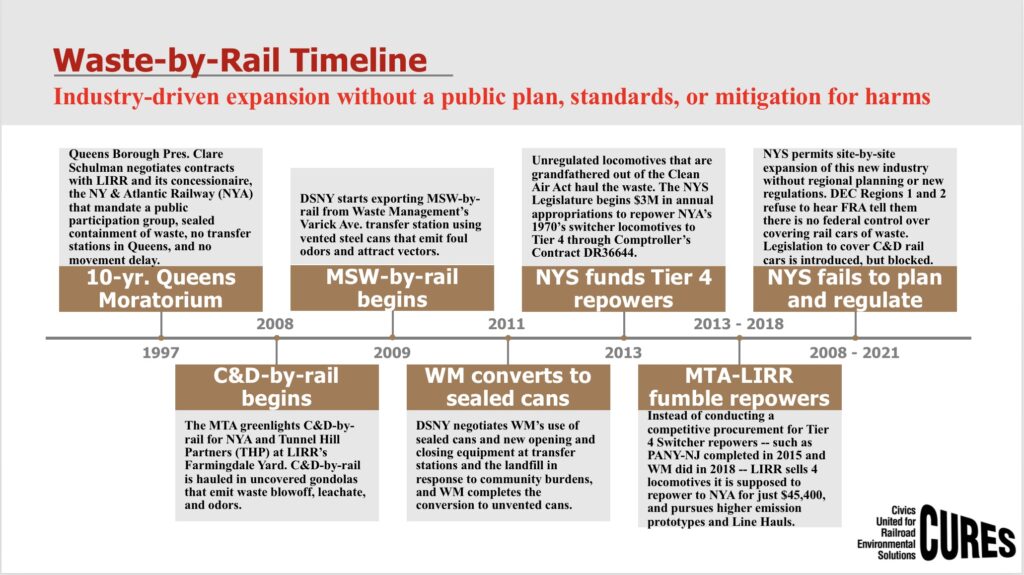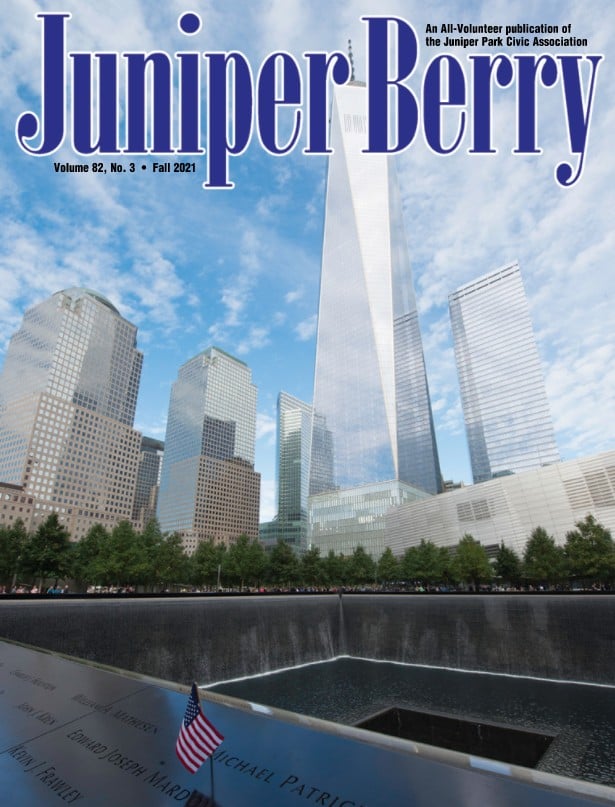The main takeaway from this waste-by-rail timeline is that promises were made in 1997 to protect families and the environment from adverse impacts of waste-by-rail, and those promises have not been kept. The question now is will Governor Hochul finally help the more than 500,000 residents in Queens who are being most adversely impacted by needless waste-by-rail pollution?
The timeline shows that 11 years before the waste-by-rail industry started up in 2008, Fresh Kills landfill was going to close and the Long Island Railroad had decided to license a private company to operate its freight railroad. Queens elected officials, including Borough President Clare Schulman and Assemblywoman Cathy Nolan, already anticipated the adverse impacts that privately controlled waste- by-rail could bring into neighborhoods where constituents live. These wise, elected women negotiated contracts with the MTA-LIRR and the New York & Atlantic Railway to avert problems. The railroads made promises that there would be a 10-year moratorium on waste-by-rail; no waste-by-rail transfer stations in Queens; waste would be hauled in sealed containers; there would be no delay in the movement of waste-by-rail through Queens; and there would be a public participation organization established to address issues. However, by the time waste-by-rail started up, promises in the Second Amendment to the Transfer Agreement between LIRR and NYA were not kept, and railroad management got the contract with the Borough of Queens declared null and void by the NYC Corporation Counsel.
By the time waste-by-rail started up, the federal Clean Railroads Act of 2008 was being implemented. This took away the US DOT Surface Transportation Board’s jurisdiction over transfer station operations on railroad property. Also, the Federal Railroad Administration has jurisdiction only over how hazardous waste is hauled. So, the new waste- by-rail industry started up without state or federal standards or regulations, and loopholes remain to this day.
To make matters worse, NYA has a fleet of unregulated, high-polluting, noisy 1970’s locomotives that were grand- fathered out of the federal Clean Air Act, so they can be used indefinitely. There have been a few modern improvements that have worked, including:
– the use of unvented containers for MSW;
– the purchase of one Near Zero Emissions Tier 4 Switcher locomotive with US EPA DERA and private funding that is used to haul waste.
– direct outbound shipment by rail at DSNY/Waste Management facilities;
– and fully enclosed transfer stations for Municipal Solid Waste rail shipment in NYC.
These are largely the result of actions taken by DSNY and Waste Management. Otherwise, communities are basically living with most of the same adverse impacts as when the waste-by-rail industry started up in 2008, including 1970’s locomotive technologies and open rail cars of landfill-bound waste.
All the of the environmental and health burdens of waste- by-rail are falling on the same New Yorkers day after day. Luckily there have been dramatic improvements in technology that are available, as well as common sense efforts like the city’s and those that have been approved and budgeted for by the NYS legislature. But almost none of them have been implemented. Why? We have been learning more about the reasons for this in real time. For example, the Port Authority staff’s letter of protest about the La Guardia Air Train project states in part: “For too long, Gov. Cuomo and his staff have repeatedly pushed the agency to make non-transparent, politically motivated decisions, including decisions that squander the trust and money of our bondholders, customers, and the general public.” LI Congresswoman Rice’s comments about the Moreland Commission in Ronan Farrow’s New Yorker article include this quote: “As we began to peel away the layers of the onion, (Cuomo) was behind everything,” Rice said. “I mean, the corruption began and ended at his doorstep.”
Under the control of Governor Cuomo, the MTA-LIRR has failed to conduct two real and fair competitive procurements to complete a Tier 4 Switcher locomotive repowering of the New York & Atlantic Railway’s fleet. Like the LaGuardia Air Train selection, the fix was in for winners in both locomotive procurements, which CURES closely documented.
The Governor’s Department of Environmental Conservation (DEC) has failed to acknowledge that the US DOT Surface Transportation Board and Federal Railroad Administration have no jurisdiction over covering waste-by-rail. His DEC has failed to update rules to establish standards for waste- by-rail, even when Riverkeeper made the case for that during the Part 360 update. DEC has failed to conduct regional waste-by-rail planning. Instead, DEC has permitted expansion of this new industry without mitigation on a site- by-site basis, even in Environmental Justice communities, most recently Brentwood.
So now that we are in a new day for New York City and State, what opportunities are there to move forward? With Assemblyman Hevesi’s leadership, the NYS Legislature already has appropriated $27M — $3M a year since 2013 — to repower NYA’s fleet, which would eliminate at least 95% of NYA’s locomotive pollution forever. Spend the remainder of the $27M in NYS appropriations that should be in Comptroller’s Contract DR36644 on a straightforward Tier 4 Switcher repowering, such as PANY-NJ accomplished at NYNJ Rail in 2015, and Waste Management accomplished in 2018. This must include the repowers of locomotives LIRR was supposed to repower but instead sold to NYA in 2014 and 2017, as LIRR President Eng promised Queens elected officials.
Enact state regulations to contain all waste spillage, blowoff, leachate, and odors in rail cars/containers and in fully enclosed transfer stations.
Our civics and elected officials have been asking for this modest protection since 2009. However, “pay-to-play” NYS has allowed private waste-by-rail companies to make fortunes without first directing some profits to protective mitigation for communities. These were political and social decisions. We sincerely hope that Governor Hochul will make different decisions, keep her good government promises, and finally complete these modest projects to protect our families’ health and the environment.




